Energy Department Targets Building Envelope Efficiency
The Department of Energy has announced a $9 million investment in building envelope technology. Areas of focus include high-performance windows, roofs, and heating and cooling equipment.
“A typical American family spends nearly $2,000 per year on their home energy bills, and much of that money is wasted on air leaks and drafts in our homes’ roofs, attics and walls. By bringing new, affordable energy efficient products to the market, we can help families save money by saving energy, while strengthening U.S. manufacturing leadership in technologies that are increasingly in demand worldwide,” says Energy Secretary Steven Chu.
While U.S. energy use per capita was fairly consistent from 1990 to 2007, building improvements in efficiency for space heating and air conditioning have helped achieve a reduction in the last five years.
While you’ve probably noticed this shift in your own facilities or building portfolios, nearly 60% of homes now feature energy-efficient, multi-pane windows – up from 36% in 1993.
About 40 million households have used caulking or weather-stripping to seal air leaks and drafts and 26 million have added insulation. The U.S. Energy Information Administration expects that energy use per capita will continue to fall by an additional 15% through 2040.
Additional improvements are needed. In a typical residential or commercial building, about 42% of energy is lost through doors, roofs, attics, walls, floors and foundations – known collectively as the building envelope.
Looked outside lately? In winter months, windows can account for 10% to 25% of a home’s utility bill through heat loss. The projects announced today will help bring new, affordable technologies to market that address these opportunities for improved building performance and cost savings for both homes and commercial buildings.
How about some specifics? For example, St. Louis, Missouri-based Unico will receive $2 million to develop a cold-climate heat pump with a variable speed compressor that will maintain capacity and efficiency even at very low temperatures.
The University of Idaho will design and demonstrate a roof sandwich panel that uses foam material to increase building thermal efficiency and helps reduce construction costs by 25%.
Lawrence Berkeley National Laboratory will develop and test highly insulated, easy-to-install windows that use automated shading that can capture or repel heat depending on the season.
